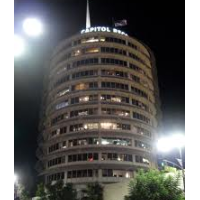Los Angeles, UC Researchers Squabble over Quake Info on More than 1,000 Vulnerable Buildings
 Capitol Records building
Capitol Records building
The city of Los Angeles is pretty sure it has more than a 1,000 big concrete buildings vulnerable to collapse in a major quake, but doesn’t know where they are and can’t quite figure out how to find them, according to a Los Angeles Times story last week.
University of California researchers have gathered a list of 1,500 such buildings but don’t want to turn it over to the city because its raw data, underlying a larger study, is derived from public records and hasn’t been verified on the ground.
Putting aside the question, “Why doesn’t the city already have the information UC gathered?” the question remains: Should this information be immediately made public?
The Times published a report last week which said the most conservative of estimates predicted that 50 of the 1,000 vulnerable buildings it earmarked (including the Capitol Records building) would collapse in a big quake. Similar warnings were sounded, albeit without the 1,000 figure, after the devastating 1971 Sylmar earthquake and again after the 1994 Northridge quake. Each time, new retrofitting regulations were passed and a selected number of buildings that were appropriate for the work were strengthened. Others were torn down.
After the 1971 quake, around 8,000 brick buildings were retrofitted or demolished. After the 1994 quake, Times reporter Doug Smith, a co-writer on last week’s story, wrote that the city was considering a massive retrofit program that could affect 100,000 structures, but that compiling accurate data would be daunting.
“That would start with our automated records and go from there,” Karl C. Deppe, chief of the Los Angeles Department of Building and Safety's building bureau, told the newspaper. But “you really have to go out and look at every building.”
And that’s why UC says it is hesitant to turn over its information to the city for a raw data dump. It hasn’t checked the info and says it is afraid of legal liability if safe structures are identified as unsafe.
The UC project was funded in 2006 by a $3.8 million grant from the National Science Foundation (NSF). One of the project’s four components is an inventory of one urban region’s concrete buildings. Using that information, the project would conduct lab experiments and computer simulations to understand, predict and mitigate how concrete structures perform in an earthquake.
Data from scientific projects like this is generally made available somewhere down the road, and the NSF’s own website makes it clear that, “Investigators are expected to share with other researchers, at no more than incremental cost and within a reasonable time, the primary data, samples, physical collections and other supporting materials created or gathered in the course of work under NSF grants.”
But the city wants it now because time is of the essence and people’s lives are at stake—just as they were in 1971 and 1994.
–Ken Broder
To Learn More:
UC Quake Researchers Refuse to Share Building Data with L.A. (by Rosanna Xia, Doug Smith and Michael Finnegan, Los Angeles Times)
Many Older L.A. Buildings Could Collapse in an Earthquake (by Rong-Gong Lin II, Rosanna Xia and Doug Smith, Los Angeles Times)
Quake Threat Puts Hollywood Skyscraper Project on Hold, Raises Questions about Others (by Ken Broder, AllGov California)
Pacific Earthquake Engineering Research Center (PEER) Receives $3.6 Million NSF NEES Grand Challenge Grant (Pacific Earthquake Engineering Research Center)
Statement on Seismic Safety Study (University of California)
- Top Stories
- Controversies
- Where is the Money Going?
- California and the Nation
- Appointments and Resignations
- Unusual News
- Latest News
- California Forbids U.S. Immigration Agents from Pretending to be Police
- California Lawmakers Urged to Strip “Self-Dealing” Tax Board of Its Duties
- Big Oil’s Grip on California
- Santa Cruz Police See Homeland Security Betrayal in Use of Gang Roundup as Cover for Immigration Raid
- Oil Companies Face Deadline to Stop Polluting California Groundwater





